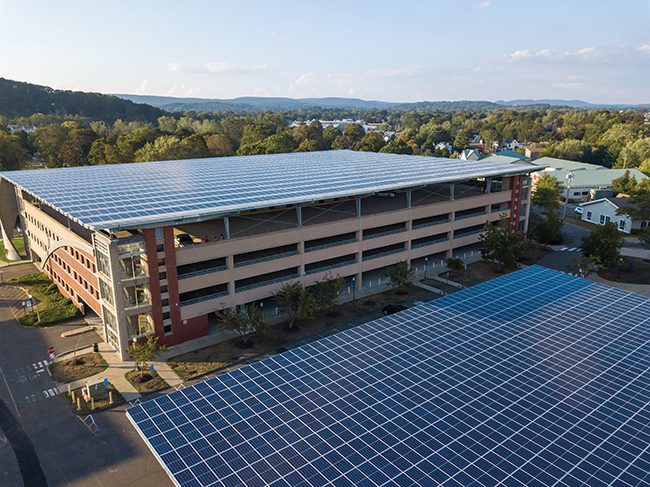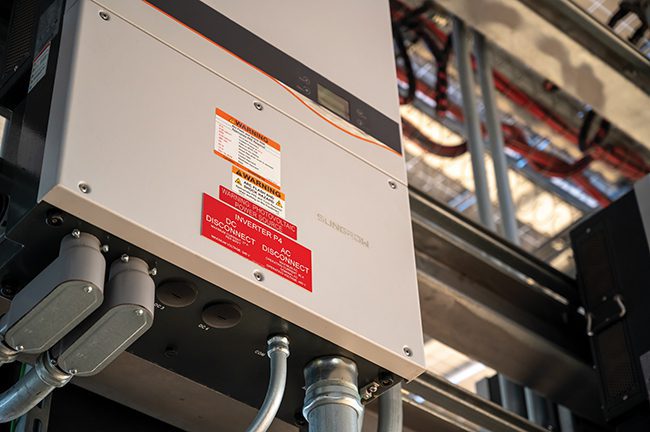Prioritizing O&M in Early Stages of Project Design Yields Big Payoff
The Connecticut State Colleges & Universities (CSCU) system wanted to install solar power to save money on energy costs, reduce its carbon footprint, and demonstrate its commitment to sustainability for increasingly green-aware students. This was a tall task for a system with 85,000 students across 16 campuses. DSD Renewables (DSD) installed 11.5 MW of solar canopies, parking lot carports (Figure 1), and ground-mount systems across nine colleges, offsetting CSCU’s traditional energy footprint by an estimated 30% annually and generating an estimated $15 million in savings over 20 years.
 |
|
1. Solar panels were installed in several locations across Connecticut State Colleges & Universities (CSCU) campuses, including on the roofs of parking structures. Courtesy: Distributed Solar Development |
DSD designed and installed the systems, all without interrupting the normal flow of campus activities. Each system was designed with operations and maintenance (O&M) in mind to ensure the systems run efficiently. The careful planning at the micro and macro level, and the hurdles encountered along the way, offer lessons in improving design, installation processes, and O&M for any project.
Maintaining Safety and Campus Flow Through Installation
Safety was a primary concern, given the number of employees, students, and community members who have access to CSCU campuses. Features were installed at each site to ensure that only approved personnel could access the installations’ equipment. Additionally, downspouts were added to the systems to channel water away from the structures and prevent icicles from forming during winter.
With parking typically at a premium at CSCU institutions, it was important to design the systems in a way that didn’t reduce the number of available parking spaces. Overall, the goal was to have the new solar installations blend seamlessly into the campus without impacting accessibility or interrupting campus life.
Construction is a significant concern for any large institution, so the installation was planned to commence during a break when students were off campus to minimize disruptions. This approach was also taken when it came time to energize the installed system.
Managing the O&M of systems located at busy sites, such as college campuses, presents an added challenge. While ongoing system monitoring, as well as planned and unplanned maintenance, are necessary to ensure the optimization of each asset, CSCU wanted to minimize disruptions and maintain a safe environment for students and faculty.
 |
|
2. Inverters in use on the solar systems at the CSCU campuses are placed in areas that provide easy access for maintenance workers. Courtesy: Distributed Solar Development |
O&M was kept in mind throughout the early stages of the project, including while designing the systems. Everything was designed and strategically placed to ensure easy access when it came time to perform maintenance. For example, while many systems have inverters spread throughout the solar array, DSD placed all the inverters in the same area (Figure 2) to make access easier for technicians.
The same concept goes with the monitoring equipment. Everything was placed in readily accessible locations adjacent to the arrays to ensure technicians had access where it was needed, particularly when they needed to course correct an issue quickly and efficiently without disrupting campus activity.
Rapid response is the key to effective O&M, allowing teams to fix issues and return the site to full operation as soon as possible. The strategy was to assure that any problems were manageable, and would not spiral into larger issues, through a program of monitoring assets daily and reviewing asset performance trends on a weekly basis.
Establishing good relationships with stakeholders onsite is an essential component of O&M; in this case, campus workers need to know who to contact when an issue arises. Similarly, it’s vital to have strong O&M technicians to call on. These should be internal and external resources who can respond to issues as they arise and arrive on site quickly. Holding meetings with the host customer to identify major stakeholders, review site access instructions, security, and communication preferences is helpful in ensuring everyone knows the site-specific protocols and the people to notify when action is needed.
Every single kilowatt-hour matters, and designing a project with O&M in mind allows for easier and quicker resolutions of mechanical and performance issues to ensure overall performance is optimized. The solar arrays installed at the Connecticut campuses approached O&M in a deliberate fashion from design to maintenance, helping keep the projects operational and meeting customer expectations.
—Chris Larkin is senior asset manager for Distributed Solar Development (DSD), where he manages fleet operations initiatives on the solar power team.